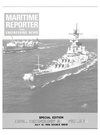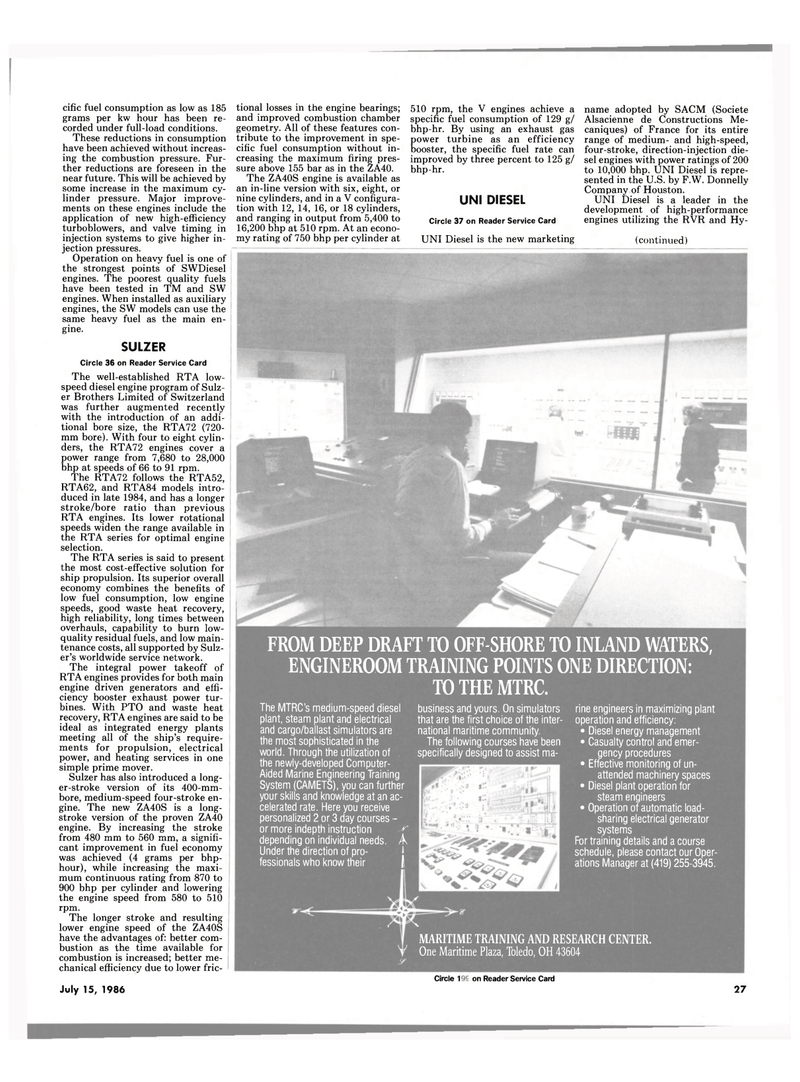
Page 27: of Maritime Reporter Magazine (July 15, 1986)
Read this page in Pdf, Flash or Html5 edition of July 15, 1986 Maritime Reporter Magazine
cific fuel consumption as low as 185 grams per kw hour has been re- corded under full-load conditions.
These reductions in consumption have been achieved without increas- ing the combustion pressure. Fur- ther reductions are foreseen in the near future. This will be achieved by some increase in the maximum cy- linder pressure. Major improve- ments on these engines include the application of new high-efficiency turboblowers, and valve timing, in injection systems to give higher in- jection pressures.
Operation on heavy fuel is one of the strongest points of SWDiesel engines. The poorest quality fuels have been tested in TM and SW engines. When installed as auxiliary engines, the SW models can use the same heavy fuel as the main en- gine.
SULZER
Circle 36 on Reader Service Card
The well-established RTA low- speed diesel engine program of Sulz- er Brothers Limited of Switzerland was further augmented recently with the introduction of an addi- tional bore size, the RTA72 (720- mm bore). With four to eight cylin- ders, the RTA72 engines cover a power range from 7,680 to 28,000 bhp at speeds of 66 to 91 rpm.
The RTA72 follows the RTA52,
RTA62, and RTA84 models intro- duced in late 1984, and has a longer stroke/bore ratio than previous
RTA engines. Its lower rotational speeds widen the range available in the RTA series for optimal engine selection.
The RTA series is said to present the most cost-effective solution for ship propulsion. Its superior overall economy combines the benefits of low fuel consumption, low engine speeds, good waste heat recovery, high reliability, long times between overhauls, capability to burn low- quality residual fuels, and low main- tenance costs, all supported by Sulz- er's worldwide service network.
The integral power takeoff of
RTA engines provides for both main engine driven generators and effi- ciency booster exhaust power tur- bines. With PTO and waste heat recovery, RTA engines are said to be ideal as integrated energy plants meeting all of the ship's require- ments for propulsion, electrical power, and heating services in one simple prime mover.
Sulzer has also introduced a long- er-stroke version of its 400-mm- bore, medium-speed four-stroke en- gine. The new ZA40S is a long- stroke version of the proven ZA40 engine. By increasing the stroke from 480 mm to 560 mm, a signifi- cant improvement in fuel economy was achieved (4 grams per bhp- hour), while increasing the maxi- mum continuous rating from 870 to 900 bhp per cylinder and lowering the engine speed from 580 to 510 rpm.
The longer stroke and resulting lower engine speed of the ZA40S have the advantages of: better com- bustion as the time available for combustion is increased; better me- chanical efficiency due to lower fric-
July 15, 1986 tional losses in the engine bearings; and improved combustion chamber geometry. All of these features con- tribute to the improvement in spe- cific fuel consumption without in- creasing the maximum firing pres- sure above 155 bar as in the ZA40.
The ZA40S engine is available as an in-line version with six, eight, or nine cylinders, and in a V configura- tion with 12, 14, 16, or 18 cylinders, and ranging in output from 5,400 to 16,200 bhp at 510 rpm. At an econo- my rating of 750 bhp per cylinder at 510 rpm, the V engines achieve a specific fuel consumption of 129 g/ bhp-hr. By using an exhaust gas power turbine as an efficiency booster, the specific fuel rate can improved by three percent to 125 g/ bhp-hr.
UNI DIESEL
Circle 37 on Reader Service Card
UNI Diesel is the new marketing name adopted by SACM (Societe
Alsacienne de Constructions Me- caniques) of France for its entire range of medium- and high-speed, four-stroke, direction-injection die- sel engines with power ratings of 200 to 10,000 bhp. UNI Diesel is repre- sented in the U.S. by F.W. Donnelly
Company of Houston.
UNI Diesel is a leader in the development of high-performance engines utilizing the RVR and Hy- (continued)
FROM DEEP DRAFT TO OFF-SHORE TO INLAND WATERS,
ENGINER00M TRAINING POINTS ONE DIRECTION:
TO THE MTRC.
The MTRC's medium-speed diesel plant, steam plant and electrical and cargo/ballast simulators are the most sophisticated in the world. Through the utilization of the newly-developed Computer-
Aided Marine Engineering Training
System (CAMETS), you can further your skills and knowledge at an ac- celerated rate. Here you receive personalized 2 or 3 day courses - or more indepth instruction f depending on individual needs. A
Under the direction of pro- fessionals who know their I business and yours. On simulators that are the first choice of the inter- national maritime community.
The following courses have been specifically designed to assist ma- rine engineers in maximizing plant operation and efficiency: • Diesel energy management • Casualty control and emer- gency procedures • Effective monitoring of un- attended machinery spaces • Diesel plant operation for steam engineers • Operation of automatic load- sharing electrical generator systems
For training details and a course schedule, please contact our Oper- ations Manager at (419) 255-3945.
MARITIME TRAINING AND RESEARCH CENTER.
One Maritime Plaza, Toledo, OH 43604
Circle 135 on Reader Service Card 27

 26
26

 28
28
